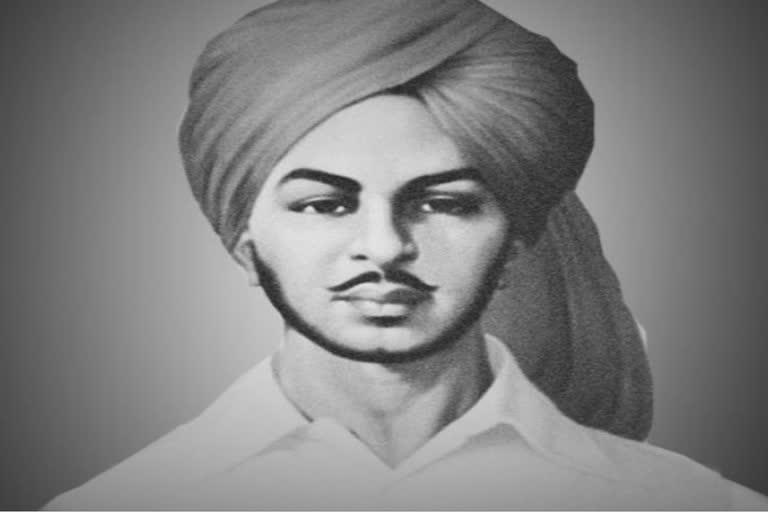Chandigarh: The Indian Independence Movement, widely known for its non-violent methods, gave birth to a number of revolutionaries. Among them, one name stands out from the rest: Bhagat Singh. Did you know he is a revolutionary who had shot only one bullet in his fight against oppression?
The revolutionary believed that a body can be killed but not a strong mind as ideas and thoughts would remain immortal. His life is living proof of that notion.
Bhagat Singh was born in Lyallpur in undivided India (now in Pakistan) on September 28, 1907. He grew up seeing his father and uncle who had connections with the Hindu reformist movement Arya Samaj and Ghadar Party. His ancestral house is still protected by Bhagat Singh Memorial Foundation in Lahore, Pakistan. The foundation is seeking martyr status for this revolutionary of all times.
The Jalianwallah Bagh massacre happened when he was 12, and he himself went to the site to collect the soil from there.
Until 1928, Bhagat Singh was like any other angry young man who wanted to drive out the British from the Indian soil. A voracious reader and writer, pen was his sword in the fight against colonial forces. Born in a political family, seeds of revolution were sown in his mind even before he attained puberty.
Life-changing moments
The arrival of the Simon Commission and the subsequent death of Lala Lajpat Rai, a moderate leader who supported Mahatma Gandhi's non-violence movement, was the decisive moment in Bhagat Singh's life.
The 7-member Simon Commission formed to review constitutional reforms for India did not have a single Indian in the panel. Protests erupted across the nation against the Commission and Lala Lajpat Rai was at the centre-stage of protests in Lahore.
Bhagat Singh and his friends joined Lala's protest in Lahore and showed black flags to the Simon Commission. Bhagat Singh witnessed how the British, under Superintendent of Police James Scott, crushed the protest with force. Subsequently, Lala Lajpat Rai who was injured during the incident succumbed to injuries, sending a shock wave throughout the nation.
Bhagat Singh and his Hindustan Socialist Republic Army stood up for the entire nation and decided to teach the British a lesson for their violence. They decided to retaliate against the savagery of the colonial police.
On 17 December, Bhagat Singh and his comrades Rajguru, Sukhdev and Chandra Shekhar Azad gunned down 21-year-old John Saunders, mistaking him for James Scott. Bhagat Singh and Rajguru evaded arrest for months and continued their activities to avenge the death of Lala Lajpat Rai.
By this time, Bhagat Singh and his 'Inquilab Zindabad' slogan became a rage in the minds of the people. The slogan, originally coined by the Urdu poet, freedom fighter and leader of All India Muslim League Maulana Hasrat Mohani in 1921, was popularised by Bhagat Singh during the late 1920s through his speeches and writings.
Daring the British to arrest him
On 8 April 1929, Bhagat Singh and Batukeswar Datta hurled a bomb in the Central Legislative Assembly Hall in Delhi. They threw the bomb from the midst of a packed gallery from above the legislators' seats, not aimed at anybody, but to draw the attention of the House, the Indian people and the British rulers in India. They hurled pamphlets saying explosions are needed to wake up the deaf government and waited for the police to make them arrest.
As it was just an explosion and nobody was hurt, they were sentenced to life imprisonment. But the British who wanted to hang Bhagat Singh by any means opened an investigation into Saunders murder.
On October 7, 1930, the tribunal found Bhagat Singh, Sukhdev and Rajguru guilty of Saunders' murder and sentenced them to death. In the jail diary of Bhagat Singh, it is mentioned that in his short span of 23 years, he had only shot one bullet, according to historian Amolak Singh.
The anger and frustration of British rulers did not stop there. They hanged the three revolutionaries on 23 March 1931 when a huge crowd gathered outside the Lahore Jail. They did not give an iota of importance to the widespread protests against the hanging of three youngsters in their 20s. Gandhi also appealed to the government but in vain.
His ancestral house is still protected by Bhagat Singh Memorial Foundation, Lahore, Pakistan. They are also demanding national martyr status for Bhagat Singh.
Lahore based Bhagat Singh Memorial Foundation is demanding National martyr status for Bhagat Singh.
And in India, till date, the brave act of Bhagat Singh brings tears as well as pride to any Indian who find his supreme sacrifice noble and revolutionary at the same time.



